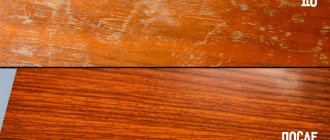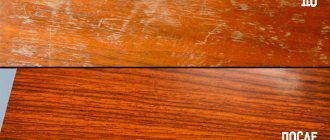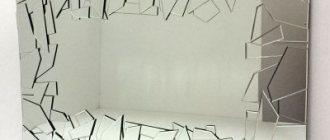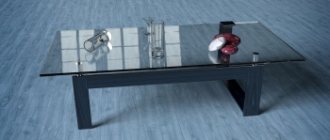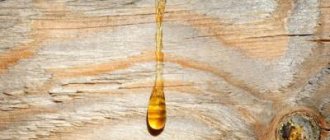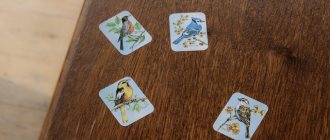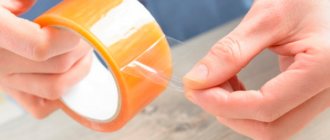Mechanical damage - scratches, abrasions - greatly deteriorate the appearance of the furniture. Even minor defects can ruin the aesthetics of interior items if they are on the front surface. Usually their cause is natural wear of wood or exposure to external factors.
There are different methods to remove scratches from furniture. Using inexpensive means, you can update products and save on buying new ones.
Scratches and abrasions on wooden furniture
Laminate surface repair
Quite often, kitchen furniture is made from chipboard - chipboards, which, for greater strength, are covered with a special film - laminated. But, nevertheless, this material is not resistant to moisture, high temperatures and intense mechanical stress.
You can repair a chip or other damage at home. To do this you will have to stock up on the following materials and tools:
- shavings (sawdust will also work);
- hairdryer;
- saw;
- PVA glue.
The process of restoring a laminated chipboard countertop consists of the following steps:
- You should turn on the hairdryer and warm up the damaged area;
- after drying, the peeled coating should be removed;
- the area is covered with a layer of glue and left alone for a quarter of an hour;
- prepare a mixture of sawdust or glue and infuse for 10-15 minutes;
- the composition is poured into the recess and compacted with a spatula;
- excess glue is removed and the table is left to dry for 24 hours.
To protect the countertop from moisture, especially in previously damaged areas, it is recommended to seal the most vulnerable areas with a sealant. This method is also suitable for removing chips on an MDF tabletop.
Upgrade with PVC film
Restoration does not always mean only returning facades to their original appearance and replacing fittings. Modern methods of decoration make it possible to change the appearance of a kitchen beyond recognition, using quite affordable means.
One of these options is vinyl film, or rather, a sticker with an image on PVC film. Moreover, the image can be anything - from a wood pattern to an ornament of any complexity or a landscape.
Quite often, this technique is used to change the style of the kitchen or simply diversify the design. To do this, decorate an area or two doors with a sticker. If they want to update their entire set, all facades are covered with vinyl film. The choice is entirely determined by the style of the room.
Paneled facades are very suitable for such kitchen renovations. The frames are painted or also covered with a film of a different color, and the inner surface is decorated with self-adhesive film.
The photo shows a successful solution in the Art Nouveau style.
Restoration of artificial stone countertops
Despite the strength of this material, flaws may appear on it and you can get rid of them at home. To remove a scratch from a kitchen countertop, a mixture of polyester resins is required, which makes even significant defects invisible.
The restoration proceeds as follows:
- around the damaged area it is necessary to clean the surface and degrease it;
- particles of material are removed from the recess, it is expanded and made deeper;
- the damage is covered with polyester resin and left to dry for 20 hours;
- Afterwards, the tabletop is sanded, first with an abrasive material and then with felt.
This kind of work is quite painstaking and requires certain skills in working with the tool. Therefore, if you have no experience, you can contact a specialist.
First aid
If there are various scratches and stains on interior items, do not despair, but immediately begin solving the problem.
You can do the work yourself. You can remove scratches from furniture at home using special products purchased in the store. Even if everything is in order with the furniture, it won’t hurt to buy similar “magic wands”. One of them will be a furniture touch. It is simply irreplaceable for removing scratches from both wooden and laminated surfaces. This item is affordable for everyone. Another advantage of the stroke is that it has a huge number of colors. Thanks to this, you can mask surface defects of any table, chair, cabinet or other furniture.
Just do not forget that its use is carried out exactly according to the instructions. Otherwise, improper use may result in a spoiled mood and the inability to restore the appearance of the property.
For defects on chipboard surfaces (which are not so rare), wax will work well. But here, as in the previous version, it is necessary to choose the right color. Before using the product, you should make sure that the surface is completely clean of dirt and dust. Only after this can you rub wax into the damaged area.
After this procedure, you need to level the surface using an edging knife. Then you need to wait for it to dry completely. After this, it is worth wiping the surface with a fluffy cloth specially designed for polishing. When lacquered furniture becomes scratched, wax can also come to the rescue. It will not only remove defects, but also give the interior item a radiant shine.
Repairing damage to a plastic table
Quite a popular material used for the manufacture of kitchen furniture, which does not swell or get wet. However, mechanical stress on plastic furniture often leads to the formation of cracks or chips, especially in the kitchen.
To repair such a countertop, you will need a special adhesive composition intended for plastic products. This will allow the loose covering to be reattached.
If minor flaws appear on the table - cuts, scratches, then you can do without expensive glue; you can also use regular instant glue for these purposes.
If a large piece breaks off, then it is best to use Titan glue. The plastic is ground to a powder state, mixed with an adhesive, and the damaged surface is sealed with this mixture.
Final tips
Cleaning your kitchen with a steam cleaner.
Thick curtains that protect glossy furniture from sunlight.
We can say in favor of glossy surfaces: dirt does not eat into them, so it is better to rub them once a week with microfiber with a special product and enjoy the pure shine, than to flatter yourself with the hope that there is no dirt on matte facades - which means there is no need to wipe them.
If you make it a habit to “automatically” wipe kitchen cabinets, tables, facades, etc. every day. with a damp cloth, then once a month you won’t have to rub them until they shine and your hands will tremble, nervously remembering the day you chose gloss (on your head).
Thus, if your kitchen facades are covered with glossy enamel, acrylic, paint or film, just follow our care recommendations - and they will retain their shine and rich colors throughout their entire service life.
In the modern world, plastic surrounds us everywhere, be it car panels, window sills, sunglasses or a mobile phone. The distribution is due to the fact that it is light in weight and easy to handle. Nevertheless, it is susceptible to damage, so sooner or later the question arises of how to remove scratches from plastic on this or that thing.
Most often, damage can appear on car parts, for example, the dashboard or doors, this may be due to the careless placement of keys, phones and other objects on it. It's also quite easy to scratch glasses that have a plastic base when they are carelessly placed on a table or in a bag.
Restoring integrity to a glass tabletop
If chips or other defects appear on glass furniture, then restoration on your own is impossible. To remove even the smallest scratches you will need professional equipment. If there is significant damage, the table cannot be “reanimated” and there is only one way out - replace the product with a new one.
To protect the glass from scratches, it is recommended to use fabric coasters or cover it with a tablecloth.
Damage to the countertops can be associated both with poor-quality material from which they are made, and with improper use. However, regardless of the reason, in most cases, there are ways to fix it.
How to remove grease stains from glossy furniture
You won't be able to avoid stains from greasy hands or food marks on the surface of furniture. But several secrets will help reduce the time of labor-intensive cleaning:
- Prepare paper towels. You can wipe the surface of glossy furniture on which a stain has just appeared with paper towels or napkins. It is enough to blot the greasy stain and not a trace will remain of it.
- We use warm water. There is no need to rush to use more aggressive chemical cleaning products. In a situation where a stain has just appeared on the gloss, a sponge or cloth moistened with warm water can eliminate the problem.
- We use soda. Difficult, old stains from a glossy surface can be removed with baking soda. The powder is mixed with water to form a paste and gently applied to the stain.
After ten minutes, the soda slurry is carefully removed with a paper napkin.
Taking into account all the recommendations for glossy surfaces, the cleaning process will go faster, and the furniture will retain its shiny appearance longer.
The main causes of scratches
Before you start eliminating scratches, you should find out the reasons for their occurrence. This is necessary in order to prevent the formation of defects in the future. The main reasons include:
- Exposure to abrasive substances, including sand and dust. For this reason, minor and barely noticeable defects appear on lacquered furniture.
- Damage caused by pets' claws or various sharp objects.
- External mechanical influence. The largest and most problematic chips appear from impacts from furniture.
Removing scratches from polished furniture
Method 1
- Mix water and vinegar in a 3:1 ratio.
- Pour 2 tablespoons of vegetable oil into the solution.
- Soak a cotton swab in the mixture.
- Rub the scratches until they disappear.
- Polish the surface of the furniture with a flannel cloth or lint-free cloth.
This is interesting! Thanks to this method, you can not only get rid of scratches on furniture, but also protect its surface from dust, because it will settle much less.
Method 2
A labor-intensive but effective option is to use furniture polish:
- Take special equipment.
- Apply it to damaged areas of furniture.
- Rub until the scratches disappear.
Method 3
Uses of walnuts:
- Peel one nut and remove its core.
- Rub the inside of the walnut onto the scratches on the furniture so that the nut oil penetrates into the material.
- Wait a couple of minutes until the scratch begins to darken.
- Repeat if the effect is not fully achieved.
How to remove scratches
Detected defects can be removed using improvised or specialized means. If there is serious damage, it is possible to combine several methods.
Special marker
A marker has been created for processing a polished surface, which allows you to restore the attractive appearance of the product. The principle of operation of the marker is the penetration of microparticles into cracks and subsequent filling of the scratch. The marker is colorless and has a consistency similar to paints and varnishes. The applied substance on the surface is not washed off with water and creates protection against new scratches.
Other popular methods
There are some scratches that can be easily removed with steam. The only drawback of this method is the possible damage to some types of surface.
Therefore, it is not suitable for everyone. Deciding
, this option should be considered as one of the possible ones.
Before you start processing, you need to prepare gauze and a modern iron with steam in advance. The gauze needs to be folded in several layers, pour water into the iron and release steam from it. By performing these simple steps, you will notice how the wood swells and the scratch gradually disappears. But you should understand that this method will be effective for minor scratches. And for damage on white surfaces, shoe polish is good.
Folk remedies
Various products have become popular among people that also effectively eliminate damage to furniture. Most of the methods described do not require any special costs and are easy to use.
Walnut kernel
When rubbing scratches with a walnut kernel, the damaged area is gradually filled with mass and becomes almost invisible. The procedure can be performed several times in a row to achieve a better effect. It is possible to replace the kernel with nut oil and wipe the scratches by applying the substance to a napkin.
Mayonnaise
The effectiveness of mayonnaise is ensured by its strong penetration into the wood structure. Mayonnaise should be applied to the damaged area several times with an interval of 2 hours. After treatment, the wood will swell and the crack will fill on its own. This method can eliminate defects on any wooden furniture.
Vinegar with vegetable oil
It is recommended to treat light furniture with a mixture of olive oil and vinegar, using the components in a ratio of 5:2. The damaged area is wiped with the mixture and left for a day for complete absorption. Then the furniture is polished with a rag.
Sandpaper
Fine-grained sandpaper helps remove defects on steel furniture elements. The damage is smoothed over with sandpaper and, if necessary, treated with putty. After the material has dried, paint is applied to match the color of the product to mask the area.
Mastic
You can paint over small scratches on wooden products with mastic. The material is distributed on the surface and rubbed with a napkin. To make your own mastic, you need to melt 40 g of wax, add 30 g of turpentine and a teaspoon of alcohol, and then mix thoroughly.
Colored crayons
Colored crayons contain wax, which allows you to paint over scratches. To achieve the desired effect, you just need to choose the right color crayons.
Paraffin
Candle paraffin is kneaded, applied to the damaged area and rubbed until the defect is eliminated. When processing glossy furniture, you need to wipe the surface with a soft cloth after completing the restoration. It is enough to remove the remaining paraffin from the matte surface.
Eyebrow pencil
Applying an eyebrow pencil to scratches can visually hide them.
The disadvantage of using this method is that the pencil wears out quickly, which is why you have to constantly touch up defects on the furniture.
By mixing ground coffee beans with a small amount of liquid, you get a semi-thick substance to remove scratches. Apply the substance to the scratches using a cotton swab or disk. You can eliminate defects with coffee only on dark furniture.
Lemon juice and oil
A mixture of lemon juice with vegetable or olive oil in equal proportions is also suitable for treating damaged furniture. The mixed components are applied to a clean, lint-free cloth and the surface is polished, making movements in the direction of the scratch.
Basic methods of plastic restoration
Scratches on plastic can be superficial or deep. This is easy to check with your fingertips and nails. Small scratches and pronounced grooves are repaired in different ways.
Surface scratches
Minor damage can be removed from soft plastic by polishing. The scratched area is cleaned of dirt and grease with a cloth moistened with warm soapy water.
Next, the dried, clean surface is polished with one of the following products:
- a small amount of toothpaste
- a mixture of soda and water,
- furniture varnish,
- special polish.
Finally, the remaining product is washed off with wet and dry clean rags.
Shine on glossy plastic can be achieved with furniture varnish or car wax. The treated area is rubbed with a woolen cloth until it shines.
Deep scratches
Defects of this kind are first sanded with sandpaper. The work uses sheets of different grain sizes, depending on the depth of the scratch.
The emery is moistened with water and sanded extremely carefully so as not to damage entire areas. The leveled surface is polished with a special paste until smooth.
Deep lines on colored plastic are tinted. You can use coloring pencils from automotive household chemicals. Before restoration, the surface is cleaned and degreased. After drying, it is coated with colorless varnish. The work is completed with polishing wax.
How to hide deep cracks
Very noticeable damage to furniture cannot be easily hidden with improvised means. To restore the original appearance and restoration requires a comprehensive approach to solving the problem.
Preparing the site
Before starting work, you need to thoroughly clean the surface of the furniture from dust and dirt. The cleaned area is coated with a degreasing agent and allowed to dry. Also at the preparation stage, you need to decide what material will be used to hide defects.
Applying the material
The purchased material is applied with a suitable tool or cotton pad to the damaged area. When applying, try to ensure uniformity. Excess material is carefully removed with a spatula.
Grouting the surface
After treating the scratched areas, you need to wipe the surface. During this procedure, the furniture coating becomes smoother and more even. As a rule, fine-grained sandpaper is used for grouting.
Painting
A layer of paint is applied on top of the applied masking material, which matches the color of the rest of the furniture. Paint not only visually hides defects, but also provides additional protection against new damage.
Useful tips
Oddly enough, amateur attempts to repair chips or restore more serious damage to furniture sometimes cause more damage than simply tinting or painting a furniture touch.
For example, you should not use water-based dyes to fill scratches, cracks and swelling of furniture veneer. Do not use iodine, strongly brewed tea, an aqueous solution of potassium permanganate, watercolors, gouache, or car varnishes. As an exception, you can temporarily mask scratches on furniture with walnut.
All of the above can hide the damaged area for a while, but, as a rule, it causes swelling of the decorative coating due to swelling of the wooden base of the furniture.
The largest chips and even breaks, which often happen on armrests or the ends of doors, cabinets, especially kitchen furniture, can be treated by applying a repair varnish layer to the entire front surface. In this way, it is possible to preserve the mirror of the lacquered surface, and this is the most important thing in the restoration of wooden furniture. If you repair chips and the entire panel of furniture with “solid” varnish, then the damaged area may not be visible even with the most careful examination.
Features of working with glass surfaces
In order not to damage the fragile glass surface, you need to take into account a number of nuances during processing. The main rule is to be careful. It is also important to select suitable products that do not harm glass products to complete the work.
Paste GOI
Deep scratches on glass can be removed using GOI paste. If possible, glass should be removed from furniture for ease of processing. A small amount of paste is applied to the fabric and spread over the surface. Then rub the product in a circular motion into the damaged areas. Remains of GOI paste after treatment are removed with a damp cloth.
Nail polish
Minor scratches on the glass coating can be easily masked with nail polish. A prerequisite is the transparency of the varnish. The substance must be applied with a brush to the scratched areas and wait until the varnish fills the crack and dries. The remaining varnish is carefully wiped off the surface with a soft cloth.
Important point
When deciding how to remove scratches from furniture of dark color, light or colored surfaces, you need to take one nuance into account. It is impossible to say with certainty that this or that shade is suitable for masking scuffs and defects.
Even if you have a good memory and great confidence in your actions, you cannot immediately apply a camouflage agent to the product. It is best to apply the chosen product in an area that no one will see. If the shades combine well, you can proceed to application to the front surface.
How can you restore furniture made from laminated chipboard?
Furniture made from laminated chipboard is found in every home and office. This is the most budget-friendly and quite decent-looking furnishing option. In more expensive versions of furniture, only the body is made from chipboard, while the facade part is made from MDF with various types of cladding (PVC film, veneer, enamel) and solid wood. MDF and solid surfaces may also require restoration, but we will not talk about them. This article contains information on how to restore chipboard with a laminated surface with your own hands .
Do-it-yourself chipboard restoration can be of several types:
- Restoring the color of a worn (worn) surface.
- Masking chips and scratches on the surface.
- Restoration of chipped ends of chipboard furniture.
- Restoration of places with torn fasteners and hinges.
Each of the defects requires its own approach to restoration and a different set of available tools.
How to restore the shine of a glossy kitchen surface
Kitchen surfaces get dirty faster than others in the apartment. During cooking, droplets of fat fly throughout the room. They settle on the walls of cabinets, countertops, and hoods. Over time, the fat forms a continuous sticky film, to which dust, pet fur, and dust blown in during ventilation are firmly stuck. Furniture in the stove area suffers the most.
Another vulnerable spot is the handles of cabinets and drawers. The area around is usually covered with a thick layer of prints, to which more and more dirt is gradually added.
- For kitchen sets with a shiny finish, it is better to use microfiber cloths or homemade flannel cloths. After washing, the surface should be wiped dry with a paper towel - this will help avoid streaks;
- Aerosol detergents are a convenient solution for cleaning kitchen surfaces. Spray Cif Anti-grease spray on the cabinet doors and wipe with a damp cloth. To remove old stains, leave the product on the surface for a few minutes. The active components of the aerosol break down kitchen dirt and enhance the shiny effect;
- General cleaning in a glossy kitchen can be carried out with universal detergents and dishwashing liquids with a degreasing effect. It is enough to squeeze a few drops onto a napkin, wipe the dirty surface and wash off the foam. Gloss does not like contact with water - it will not disrupt the structure of the coating, but will leave behind stains. Wring out napkins and cloths thoroughly before use;
- For everyday care of a glossy facade, it is convenient to use universal wet wipes for the kitchen. Soft fibers do not scratch surfaces. Thanks to a special surfactant impregnation, they easily wash away grease and dirt, leave no streaks and maintain shine. Keep napkins on hand to immediately wipe up any grease, sauce, or other spills;
- To ensure less dust settles on the kitchen façade, use special antistatic sprays for glossy coatings;
- Vinegar and water mixed in equal proportions will restore the shine to your kitchen. It is more convenient to apply the solution with a spray bottle. After drying, the facade should be polished with a flannel cloth.
Read the instructions carefully before using a new detergent. Test it on an inconspicuous area.
To make cabinet doors collect fewer fingerprints, get into the habit of opening and closing them using the handles. In addition, you can install internal closers - this will reduce contact with the glossy finish, and the door hinges will last longer.
As you have already learned, preventing scratches from occurring on your favorite surfaces is much easier and cheaper than trying to disguise them later. Scratches on surfaces are caused not only by not using a cutting board when cutting food, but also by improper cleaning with cleaning powders. Cleanipedia recommends ditching cleaning powders in favor of cleaning creams and sprays. Cif cream and spray will protect the surface from scratches and restore the shine and shine of your favorite furniture!
Originally published March 17, 2022
Restoration of chipboard furniture: what you might need
- Soft furniture wax (wax putty). Used to seal chips, scratches, cracks on wooden and laminated surfaces of cabinet furniture, interior doors, laminate and parquet. Provides moisture resistance to the restored surface.
- Hard furniture wax (melt putty). Requires melting before use (for example, using a lighter, soldering iron or gas torch). Application is similar to soft furniture wax. Recommended for restoration of chipboard surfaces with high intensity of use (countertops, shelves, floor coverings).
- Retouching agents - felt-tip pens or alcohol-based markers, valve and fiber. With their help, the texture of the material at the restoration site after waxing is completed to make it less noticeable. Ordinary felt-tip pens in shades that match the furniture, strokes, paints, even shoe polish and iodine will also work.
- Fixing varnishes, polishes (best in the form of sprays and aerosols) for surface treatment after restoration. For coating after restoration of defects, returning surfaces to their former shine, masking abrasions and minor scratches.
- Melamine edging with adhesive for replacement trim.
- Two-component epoxy composition, PVA, dowels (chops), wooden plugs for filling holes from torn hinges and other fasteners.
- Tools – plastic spatula, sandpaper, abrasive sanding sponge (fine), utility knife, hair dryer or iron, chisel, non-woven wipes and rags for finishing.
About materials for repair
Tools for repairing chipboard countertops will be useful:
- Furniture touch. Used to seal minor scratches and cracks. The required shade is selected for repair.
- Hard and soft tint wax. Used to restore areas with cracks, dents and chips. It is melted and applied to the problem area, after hardening it is given the desired shape and polished. For countertops, wax of the desired shade is selected.
- PVA glue. The composition is used to repair soaked products and holes. It is mixed with sawdust and fills the voids.
- Varnish. Used to consolidate the result. Tint compositions are used to restore worn surfaces.
- Retouching felt pen. Apply to damage or wax to give the area the desired shade and texture.
Restoration of faded and worn chipboard countertops
Often, during use, chipboard countertops and cabinet covers wear out.
A tabletop that has faded from abrasion without severe defects on the surface (deep scratches, cracks) can be restored as follows:
- Select the coloring agent according to its shade. It is best to use felt-tip pens - you can moisten a rag with them and rub in soft circular motions and walk across the tabletop until it acquires an even color. Then fix the tint with a fixing varnish.
- In some cases, it is enough to treat a chipboard tabletop with polishing mastic with pigment (available for sale for light and dark furniture) or polish for laminated furniture. After applying the product, the surface must be polished with special lint-free wipes.
Getting rid of damage
You can get rid of traces of mechanical damage on wooden surfaces using professional products and folk recipes. They must be chosen taking into account the color, texture and capabilities of the housewife. If the furniture is expensive, it is better not to save money. There is a risk of damaging the interior item and incurring additional costs.
Wax
Furniture wax can be soft or hard. The first is used to remove shallow defects, the second is used to restore parts with serious damage. An additional plus is the color range, which allows you to restore any wooden product.
Soft wax has a rich palette and is easy to use. Hard is more durable and durable.
The algorithm for working with any type is identical:
- Clean the wood.
- Heat the material.
- Apply to damage.
- Leave for 15-20 minutes to dry.
- Polish the surface.
Excess wax must be removed; it is better to use a plastic spatula for this.
Shoe polish
I don’t always use the product for its intended purpose. Housewives recommend using it to restore wooden surfaces. Shoe polish is convenient to apply with a sponge, but there is a drawback - it is difficult to choose the desired shade.
Mode of application:
- clean the wood;
- apply the product;
- let dry;
- Remove residues with a soft, lint-free cloth.
The method is effective, but temporary; after 2-3 wet cleanings, the scratch will be noticeable again.
Furniture touch
This is a ready-made restoration material that is easy to use. The appearance resembles a clerical touch; you can purchase any shade in specialized construction stores and supermarkets.
Mode of application:
- Apply the product in several layers to the damaged area using a brush until the defect is eliminated.
- Remove excess with a hard, but not sharp, object. The edge of a plastic card will do. Polish the surface with a soft cloth or felt.
To match the color, you can use a special marker or cover the area with varnish. It is better to use the product in a spray bottle. When using a furniture touch, it is necessary to take a break between manipulations for at least 15 minutes, otherwise the layers will not dry well.
Using a stroke to restore a wooden product - in the video:
stain
The universal liquid effectively removes microdamage on wood. The composition penetrates deeply into the structure of the material, colors it, but retains its texture. The stain is applied with a brush in several layers and effectively masks surface defects.
Polish
Wood furniture polishes easily mask shallow scratches, remove stains and add shine to the surface.
The funds may be based on:
- wax;
- oils;
- silicone
Oil – fills scratches and damage, the surface becomes smooth and shiny. An excellent product for removing scuffs and scratches on wooden surfaces.
Silicone is the leader among polishes. It has a more liquid composition and performs several functions:
- Fills voids caused by mechanical damage (scratches, chips).
- Cleans the surface from dirt.
- Protects the surface from moisture.
- Has antibacterial properties.
Wax – evenly covers the surface with a protective fatty film, which is an organic antistatic agent. As a result, shallow scratches become invisible.
Beeswax polish is not effective on all surfaces. Metal, plastic, glass, and natural stone should not be treated with this product.
Walnut
Walnut masks scratches thanks to the natural dye juglone. The organic compound is present in the juice of the peel and pulp.
Widely used:
- for dyeing fabrics, especially wool,
- as ink
- in the food industry and cosmetology.
Another plus is that juglone is toxic to insects and is an effective herbicide.
Walnut fruit will help to visually hide mechanical damage on wooden furniture. To do this you need:
- split the kernel into halves;
- treat the damaged area of one of the parts without using physical force;
- let the juice soak into the surface;
- remove oily shine with a soft cloth.
Don't expect instant results; the effect will become noticeable after drying. You can replace the walnut fruit with nut oil, which must be applied to a napkin and treated the surface.
Restoration of chips and scratches on tables, cabinets and cabinets made of chipboard
Chips at the ends of lids and table tops, especially at radii, are not uncommon for children's and office furniture.
They can be removed altogether if the end of the furniture is covered with melamine edge. To do this you need:
- Purchase a new melamine edge with glue of the desired shade and thickness (it is usually sold in strips in the same place where chipboard and furniture fittings are sold).
- Remove the old edge by heating the end with an iron.
- Sand the end using a chisel and sandpaper until the chips disappear.
- Apply the new melamine edge using an iron, carefully cut off the excess with a utility knife and sand with a sponge or fine-grained sandpaper.
- If necessary, tint along the edge - with a stroke or felt-tip pen.
If the chips are deep enough and it is not possible to grind them off, then such defects can only be masked:
- Process the chips, clean them from dirt and give them a more regular shape with straight edges using a chisel.
- Select the shade of furniture wax. Sometimes you have to mix several different crayons; in its pure form it is unlikely that you will be able to find the right color.
- Using a plastic spatula, lightly fill the chip with furniture wax and compact thoroughly.
- After the wax has dried, carefully cut off the excess using a spatula or a utility knife until the surface is level and the edge is straight.
- Sand with a rag, if necessary, restore the texture close to the overall chipboard pattern using retouching felt-tip pens (short thin lines, smearing the borders with a napkin). Afterwards, fix the result with a fixing varnish.
In a similar way, deal with scratches and dents - select the wax or stroke according to the shade, fill it until it is level with the surface, sand it, retouch it and treat it with a fixing varnish or polish.
Step-by-step instructions for repairing kitchen countertops
If desired, repairing a countertop made of laminated chipboard can be easily done with your own hands. The restoration technique depends on the type of damage. The more significant the defect, the more time and money will have to be spent on eliminating it.
A bloated tabletop looks ugly and spoils the overall impression of the interior. This problem occurs due to large amounts of moisture getting on the furniture. In this case, the plastic coating often remains in good condition, and the wood-chip base swells.
How to restore a tabletop with a swollen wood base:
- All voids formed from delamination are cleaned of sawdust. The tabletop is removed and put in a warm, dry place to dry. During drying, it should not get wet.
- When the tabletop is completely dry, it is installed in place.
- In a separate container, mix PVA glue with dry sawdust. The resulting mass should have the consistency of a thick paste. This will allow it to keep its shape well and “set” quickly.
- Problem areas are filled with a mixture of PVA and sawdust. The mass is compacted as tightly as possible into the voids. While it is not dry, it is leveled using a spatula or a wide knife.
- The tabletop is clamped with a press. It is left in this form for a day.
- After the composition has dried, the press is removed. Problem areas are cleaned, leveled, and then sanded to make them smooth. The seams are treated with silicone and then fixed with plastic strips.
We suggest you read How to remove chewing gum from hair, clothes, shoes, carpets and furniture
To prevent the surface from getting wet, its edges are pre-treated with a silicone compound or sealed with a plastic strip.
Cracks
Due to temperature changes, high humidity or improper use, the countertop may crack. If the damage is not very large, repairing it will not be difficult:
- PVA glue is drawn into a syringe without a needle. If the crack is small, use a tool with a needle.
- Fill the crack with glue. Its excess is removed with a napkin.
- Clamps are placed on the sides of the crack to tighten the surface. The table is left in this form for a day.
- Then the clamps are removed. The remaining glue is cleaned off. If necessary, paint over the crack with a retouching felt-tip pen.
If the crack goes through the entire countertop, it cannot be repaired. Even if the parts stick together, one of them will soon fall off.
Chips usually form on the corners or edges of the product. They are recesses that differ in color from the film coating. Sometimes such damage appears in the center of the working surface. Repairing chips is the most labor-intensive, but it is still possible to repair such damage.
How to repair a chip on a chipboard tabletop:
- The chip is ground with a chisel and sandpaper so that its edges become as smooth as possible.
- The wax is melted using a special device or lighter so that its consistency remains viscous. The composition is applied to the chip site with a reserve.
- When the wax has completely hardened, it is given the desired shape with a chisel. The wax is cut to create a smooth corner or edge.
- The problem area is sanded with felt so that it becomes even and smooth.
- The color and texture of the area are restored using a retouching felt-tip pen. When drawing lines, they are periodically smeared with a soft cloth to mask the visible boundaries.
- At the final stage, varnish is applied. It is distributed over the entire surface. This will add shine to the countertop and seal the result.
If the chip is in a noticeable place and after applying wax it is not possible to restore its color and texture, then a special polymer film is glued to the entire tabletop. It imitates different textures and makes the product uniform.
Scratches
Scratches are the most common type of damage on kitchen countertops. They occur when cutting food directly on the work surface. Fortunately, getting rid of them is easy.
How to disguise cracks:
- Apply wax to the scratch using a rubber spatula. The paste is packed as tightly as possible. It is advisable to use soft compounds.
- Polish the surface with a soft felt cloth to make the problem area smooth.
- The texture is restored using a retouching felt-tip pen. After drawing the lines, the edges of the pattern are rubbed to remove noticeable borders.
- A colorless fixing varnish is applied to the entire work surface.
There is another way to remove scratches. It is no less simple:
- Fill the cracks with a furniture touch of a suitable shade.
- Then rub it with a felt cloth to level the surface.
- A fixing varnish is applied to the entire tabletop in several layers.
Scuffs
Scuffs are another common type of damage. Due to constant contact with the surface of other objects, the top protective layer wears off. Because of this, the furniture looks unkempt and old.
Restoration of a worn surface:
- A soft microfiber cloth is wrapped around the finger. It is moistened with a felt-tip pen of a suitable color.
- To hide the boundaries of the tinted area, wipe the damage with a cloth soaked in dye, going slightly beyond the edges.
- The tabletop is coated with a fixing varnish. To hide the repair site, choose a tint varnish.
If you cannot find a marker that matches the color, use a special self-adhesive film. It is applied to the surface, gradually peeling off the protective layer and eliminating air bubbles from underneath it.
Another way to eliminate scuffs is to treat the entire surface with tinted wax. To do this, a soft composition is applied to felt fabric and rubbed over the surface. After this, the table is covered with a layer of fixing varnish.
Advice! These methods can also be used to restore a small desk.
Holes on chipboard countertops appear due to physical impact. They can be through or appear as dents. There are two ways to repair them.
Repairing holes with glue:
- The hole is cleaned of sawdust and particles that do not adhere tightly to the surface. Its edges are made as smooth as possible.
- PVA glue and sawdust are mixed in a separate container. The result will be a thick paste, reminiscent of wet sand or soft plasticine. Then it will keep its shape.
- The hole is filled with a mixture of sawdust and glue. The mass is driven in as tightly as possible and pressed in with a rubber spatula so that no voids remain.
- The tabletop is left until the adhesive composition has completely dried. As a rule, it takes 10-12 hours.
- After the adhesive has dried, the filled hole is leveled using a metal spatula and sandpaper. The tabletop should be absolutely smooth.
- A piece of microfiber cloth is impregnated with a felt-tip pen of a suitable color. A cloth with dye is used to treat the problem area. If necessary, the texture is restored with a retouching felt-tip pen.
- The tabletop is varnished.
We suggest you familiarize yourself with How to remove glue from wallpaper after gluing: remover
There is a second way to eliminate holes on the work surface. For this you will need hard wax:
- The hole is cleaned of fallen pieces and sawdust. The edges of the hole are made as smooth as possible.
- The wax is melted using a lighter. They fill the hole.
- The composition is left until completely hardened for 2-3 hours. After this, excess wax is removed with a spatula and sanded. The problem area is rubbed with a soft cloth.
- The color and texture of the filled hole are returned using a retouching felt-tip pen.
- The tabletop is covered with a layer of varnish.
Burns
Burns occur when hot dishes are placed on the countertop. Because of this, the protective layer melts or even chars. The following steps will help restore the surface to an attractive appearance:
- The charred coating is rubbed down using sandpaper of different grades in several stages. If the damage is deep, then it is removed with a chisel, and only then treated with fine-grained sandpaper.
- The problem area is smoothed using soft wax of a suitable shade. It is applied to the area with a rubber spatula, trying to distribute it evenly over the surface.
- The problem area is sanded with a soft felt cloth.
- The texture is restored using a retouching felt-tip pen.
- The tabletop is coated with a fixing varnish.
Restoration of a chipboard cabinet
Do-it-yourself restoration of a cabinet made of chipboard may also be necessary in cases where hinges and other fasteners are pulled out of the side walls due to excessive load.
Since the hinges cannot be moved to another location, they have to be strengthened somehow, the place of the torn fastener restored, and screwed in again. This can be done in the following ways:
- Drill out the joint with a drill with a diameter of 8 mm and drive in the chop. You can then screw a self-tapping screw with fasteners into it, but only after drilling with a thin drill - otherwise the chop may burst. If the edges of the chip do not overlap with the fittings, by analogy with the cases discussed above, fill them with furniture wax of a suitable shade and polish them.
- After drilling out the joint and cleaning the chipboard from crumbling parts, you can fill it with a two-component epoxy compound or glue mixed with shavings. After hardening, you can screw in the fasteners.
Problem #1. The entire facade is stained and stained
We dare to assume that you already have a whole arsenal of detergents and cleaning products on your shelf, you constantly wash and rub your kitchen furniture, but it still has “fingers” and drops all over it. These are the first questions gloss lovers might have.
How to remove fat?
There are now many products on sale for degreasing dishes and furniture. You can even use regular Fairy, Persil and the like. Apply the gel to a microfiber cloth, lather and wipe the facades with it. Then rinse with clean water and wipe the surface dry. For the last step, it is better to use disposable rags in rolls.
True, this method is not suitable for general cleaning. Therefore, if you fry with an open lid and splashes of fat get on the furniture, do not be lazy and immediately wipe it with a cloth before the fat “petrifies”.
What products can and cannot be used?
Remember the golden rule: under no circumstances use abrasives or substances with an aggressive composition when cleaning. A glossy kitchen cannot be washed with products that contain powder, solvent or acid - this will only erase the surface and it will become covered with small cracks and scratches.
A glossy set is very easy to spoil with cleaning powders such as Pemolux or Comet. Moreover, their destructive effect will not be immediately noticeable, but over time the gloss may become cloudy or yellow.
Products with bleach will “help” you discolor facades - such as White, Domestos, Toilet duck, Cilit Bang.
Alcohol-containing substances are also not recommended - they cause the gloss to fade and lose its original appearance.
The detergents must not contain the following components:
- alcohol;
- acetone;
- chemical solvent;
- turpentine;
- nitroglycerine;
- synthetic resin;
- chlorine.
The presence of these components may damage the glossy finish.
You can use multi-purpose cleaners such as Edelweiss, glass washing liquids (without alcohol), polishes for glossy furniture. Everything you need will shine.
Any dishwashing detergent with a degreasing effect will do.
Stores now sell special products that create a protective crystal-like film and prevent the formation of stains on glossy furniture (Amway, Ultra Gloss, VuPlex). Typically, the procedure needs to be performed every 6–12 months.
What cloth to wipe with?
Microfiber is your friend forever. You can also use flannel or flannelette fabric, disposable wet wipes, or special cloths for washing car windows, which are sold already damp in containers.
The main thing is to avoid abrasive wipes, rags and sponges with hard bristles - for example, like those on the back of a dish sponge - otherwise scratches cannot be avoided.
Then apply the polishing agent with a clean cotton or microfiber cloth and leave for half an hour until completely dry. After this, rub the furniture over the furniture again with a dry cloth to remove residual white stains from the polish.
Restoration of chipboard facades
The front part of furniture made of chipboard can rarely be restored. Similar procedures for filling scratches, cracks and dents with furniture wax turn out to be ineffective. Because light hits the surface differently, it is impossible to make defects less noticeable. Usually they resort not to the restoration of damaged chipboard facades, but to the actual renovation of the entire facade part of the furniture:
- They are covered with wallpaper or covered with artificial leather. To do this, it is recommended to remove the facades and twist the handles - this will make it neater.
- They use photo printing, hand painting and decoupage techniques. The pattern can be applied exactly to the location of the defect, and not over the entire surface of the chipboard facade.
- The facade is decorated with self-adhesive moldings and various overlays. You can find out more about furniture decor here.
- Glue strips of melamine tape of a similar or contrasting shade. If you think through the concept, this disguise of damage can look like a design technique.
What not to use
There is a strict taboo on certain products in the kitchen. They must not be used under any circumstances. These are aggressive solvents, abrasives and similar compounds.
Solvents
Plastics, polymer films, paint coatings are sensitive to the action of organic solvents. In order not to permanently spoil the surfaces of the countertops or facades, before using the product, you should study its composition indicated on the label. If the word “solvent” is there, you cannot use the reagent.
Nitroglycerine
A transparent liquid slightly reminiscent of oil in consistency cannot be used for cleaning the kitchen. It cannot eliminate pollution, and there will be no particular benefit from such an alternative. And the remaining oily stains will then be difficult to remove from the glossy surface.
Alcohol
Most alcohols, including ethyl alcohols, are solvents. Alcohol-containing liquids contribute to the destruction of the integrity of paintwork coatings and loss of gloss.
Ammonia
Ammonia is also an organic solvent. Therefore, the benefit of its use for cleaning varnished surfaces and plastics is questionable.
Polymer resins
Components of adhesives and varnishes, which are polymer resins, of course, cannot be used to clean coatings. In addition, if accidentally applied to a surface, they create the following problem: how to remove this composition from the coating.
Soda and salt
Generally harmless components, however, can cause serious harm if used inappropriately. Both soda and salt are mildly abrasive materials and will certainly leave scratches on glossy facades and destroy the shine of the coating.
Soaking
See also Vanish for furniture: how to clean a sofa at home, instructions
If the layer of chips swells under the film, you will have to apply more effort. You will need a sharp knife or spatula, PVA, a press block and clamps.
The sequence is:
- dismantle the tabletop;
- carefully remove the swollen sawdust from under the film;
- dry the product thoroughly;
- mix dried sawdust with PVA glue to obtain a thick mass;
- fill the voids with this product, compact it;
- cover with bars and press the area with clamps;
- leave for 24 hours to dry;
- remove the press, level the surface;
- use edge tape.
That's it, the renovation is complete.
Advantages and disadvantages
The film allows you to completely renew the facades of furniture, and no special skills are required to work with it. Thanks to a huge selection of textures, colors, images, you can choose the right canvas for any interior of a bedroom, living room, hallway, nursery, office. The material has gained great popularity due to its advantages, among which are:
- Low cost. Decorating will cost several times less than purchasing new things.
- Interior renovation. With the help of the material you can often change the design of any room.
- Easy installation and dismantling. Anyone can carry out the work of applying and removing the canvas, without any additional tools.
- Easy cleaning. The surface can be cleaned using a regular sponge and water.
- Manifold. A large number of shades and textures makes the catalog products universal; they fit into any interior.
- Moisture resistance. The canvas does not allow water to pass through, it can even be used in the kitchen and bathroom, but it cannot withstand prolonged wetness.
- Resistance to household chemicals. For cleaning, you can use regular detergents.
- Resistant to temperature changes. The film is not afraid of either cold or heat, even sudden temperature changes.
Like any other material, self-adhesive products are not without disadvantages:
- Fragility. The service life of even the highest quality models does not exceed five years.
- Discoloration. Over time, under the influence of sunlight, the surface fades and loses its original appearance.
- Surface preparation. The base for pasting must be level, otherwise all defects and irregularities will be visible.
- Poor abrasion resistance. In places of active friction, the protective layer will be rubbed off.
Installation process
After ordering and manufacturing the components and doors, proceed with installation steps:
- Remove the old elements of the set and unscrew the front panel from each drawer;
- Remove the screws that are attached to the box. Use the old door as an example, mark on it the fastenings that will be on the new facade;
- Before installing the hinges, make a hole for the lock on the facade that you have marked;
- Now attach the hinges from the old doors into the hole;
- Hang the new doors, first attach the hinges at the top and then at the bottom;
- Change the front on drawers and cabinets;
- In the place where you made the marks, screw the screw onto the new facade. Check that you did everything correctly and check the strength of the fastenings.
Scuffs
Scuffing is one of the easiest defects to eliminate. The depth of the abrasion is small, just rub the damaged area with a furniture felt-tip pen. You should not work it directly on the surface. It is recommended to first paint a soft cloth, such as silk, with it. And then use this rag to thoroughly treat the abraded area.
Before you begin repairing the product, you should conduct a small diagnostic and assess the nature of the damage.
In this simple way you can deal with shallow abrasions. If the size of the defect is too large, we paint the surface with a felt-tip pen of the appropriate shade, and then polish the resulting area with a piece of cloth.
Using this technique, it is possible to blur the boundaries of processing with new paint and smooth them out visually.
If it is necessary to restore a varnished surface, before painting, use fine sandpaper to thoroughly clean the area of wear, degrease it, and only then paint. After the furniture marker has dried, we coat the work area with varnish, which we also polish 16-18 hours after application.
To avoid new scratches, it is better to cover the surface with a protective compound or transparent film.
Natural wood
If scratches appear during use of solid wood kitchen furniture, they can be easily removed with a special polishing compound. For deeper damage, use a special putty, matched by color. In addition, you will need:
- Sandpaper.
- Varnish.
- Set of brushes.
Clean the damaged area from the old coating and apply putty. Then, after complete drying, remove the excess using sandpaper. The final stage is applying oil varnish to the surface. The varnish will dry and the surface will be ready for use again.
Coloring compounds are also used for restoration. To choose the right one, read expert advice:
- Odorless paint for wood furniture.
- How to paint a kitchen countertop.
Recommendations for extending the life of kitchen furniture
Prevention will help to avoid scratches, peeling and swelling of the material.
Preventive measures:
- Additional processing. Waterproof sealant is applied to the joints between the sink and the table, as well as between the table and the countertop.
- Aluminum strips protect the integrity of the coating from moisture. An edge is installed on each side of the furniture. This must be done immediately after purchasing the furniture.
- Silicone prevents the coating from swelling. When installing the countertop, treat the entire surface adjacent to the stove.
- Waterproof sealant. When replacing the sink, the product is applied to all open areas of the table.
- Special stands. Whatever the material of the countertop, taking care of the coating will help extend its service life. You should not place hot objects on the table; it is better to place fabric or foam material under them.
You should also not put foods on the table that can change its color. It is better to use a board for cutting.
This is interesting:
How to remove scratches on a refrigerator - what can you use to rub it off and paint over it?
What to do with a crack on the hob.
Features of joining kitchen countertops to each other.
How to restore veneer
Veneered furniture requires a special approach. The means are basically the same, the methods are different. For example, if after getting hit the veneer is swollen, fill a disposable syringe with PVA glue, pierce the bubble, and inject glue into the cavity. Place a piece of thick fabric on top and place a weight. If the surface is uneven (convex or concave), use a thick fabric bag with heated sand as a load.
Such veneer damage is restored in two stages. First, the swelling is eliminated, then the scratch is painted over and the coating is restored.
If the veneer is glued with alcohol glue, you can return the swollen part to its place by ironing it through a rag with a hot iron. But do not overheat the iron: the veneer may stretch. Heating level is medium.
If ironing with a dry cloth does not help, try repeating the operation with a damp cloth (wet it and wring it out well). There is a chance that the wood will swell and become more elastic. To reliably fix the swelling, you can introduce PVA there and then heat it with an iron.
If the swelling is cracked, you can also try to seal it with heating (through a rag). If it doesn’t work, tear off the peeled piece. You don’t cut it, but rather break it off: on veneer, breaks after restoration are less noticeable than cuts. Therefore, you break off the lagging piece. Remove the old glue from the damaged area and the piece of veneer (with sandpaper or a nail file, depending on the size). Next, the repair of veneer on furniture is standard: spread it with PVA glue, lay it down, aligning the fault lines, lay a thick fabric on top and place a weight until it dries.
Such veneer peeling can most likely be eliminated simply by ironing it with an iron.
Scratches and traces of restoration on veneer are removed in the same way as on wood: they are painted over with a furniture marker of a suitable shade. If the scratch is deep, a little melted furniture restoration wax is applied to it (with a spatula). After drying, the wax is ground, and if necessary, fine-grain sandpaper is used, but after this treatment, the restored piece is covered with a layer of varnish.
Do-it-yourself furniture restoration requires patience and accuracy. You have to act gradually and methodically: smear it, wait for it to dry, level it, smear it again, etc. Sometimes you have to try several methods: damage varies, as do the materials used in production (glue, varnish, etc.). But as a result, the furniture will look much better.
Source: stroychik.ru
Chipboard end for painting
In this case, cutting can be carried out without much danger, since chips and defects can easily be corrected with putty. If we are working with laminated chipboard, but still want to paint it, then we apply primer to the entire product. Primer GF-021 or Otex from Tikkurila is suitable. If sanded chipboard is used, then priming is not necessary, although it is advisable. We putty the end. I use acrylic putty with fine filler. We skin it. We should get a smooth rectangular edge. Sometimes this requires several iterations of sanding and putty. When we are happy with the edge, it needs to be secured, otherwise it will chip or crack. Putty is not a very durable and reliable material. We glue the edge with a construction bandage 4 - 5 cm wider than the end. We use PVA glue. We bend the bandage so that it sticks to the end of the chipboard and extends onto the upper and lower planes. See picture. After the glue has dried, we fill the construction bandage with fine acrylic putty. Usually one putty is used for all these works.
We especially pay attention to the strip where the bandage ends and the chipboard itself begins. Here you need to putty especially carefully so that after sanding and painting the transition is absolutely not noticeable. Dry the putty, sand with fine sandpaper, paint
We dry the putty, sand it with fine sandpaper, and paint it.
Despite the monstrous appearance on the diagram on an enlarged scale, in reality the presence of bandage and putty on the end of the chipboard, if everything is done correctly, is completely unnoticeable.
Restoration of wooden surfaces
No matter how carefully you handle the furniture, abrasions, scratches, and stains still appear. They are easy to eliminate. The main thing is to know how and with what.
- If the wooden surface has simply lost its shine, find a wood care product that contains orange oil. Take a clean sponge, dampen it slightly and microwave for 20-30 seconds. Spray the product from a spray bottle, then wipe with a hot sponge (hands should be wearing rubber gloves with a coating on the inside).
A hot sponge and orange oil will restore the shine of wooden furniture
Such transformations are possible using a marker, alcohol and wax.
